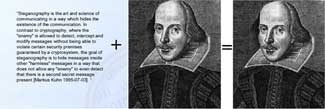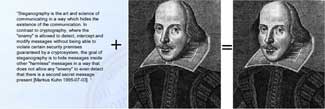 KINGSTON, R.I. — November 20, 2006 — The University of Rhode Island is helping law enforcement keep pace with computer crime by creating the latest detection techniques.
KINGSTON, R.I. — November 20, 2006 — The University of Rhode Island is helping law enforcement keep pace with computer crime by creating the latest detection techniques.
The National Institute of Justice, a branch of the U.S. Department of Justice, has awarded two, two-year grants to URI’s Digital Forensics Center, totaling $600,000, to help fight child pornography and steganography, a technique that can hide messages in innocent-looking digital documents, such as photographs. As shown here in the Shakespeare image.
Child pornography is one of the most commonly investigated forms of computer crime. To prosecute the crime, it has to be proven that the illicit image is an image of an actual child, a victim, not a computer-generated image, which is legal. Law enforcement officers can spend vast amounts of their time looking manually at each of the hundreds of thousands of images found on a typical seized computer. The Rhode Island State Police brought this problem to the attention of URI’s Digital Forensics Center.
The center will use one of the justice grants to create software to flag likely human images. Victor Fay-Wolfe, a professor of computer science and director of its digital forensics program, explains: “Our technique will automatically look for skin tones and edges indicative of humans in the image files. Our project should not only drastically reduce time and save money involved in trying to detect human images; it will also improve the accuracy of authentication, which is currently done by a pediatrician. Furthermore, the software will be user-friendly, eliminating a sharp learning curve and reducing the training time currently required of law enforcement officers.”
The second grant is for steganography detection. Steganography is a technique that uses simple software tools to hide one digital document within another. Fay-Wolfe explains: “For example, a terrorist group might hide a text message inside an innocuous digital photograph and then post the picture on, say, an EBay page for their operatives to retrieve. It will look like an innocent picture to anyone who sees it.
“Steganography is done by altering bits in the “carrier” (the photo in my example) in ways where human senses can’t detect the alteration. Changing one digital bit of a pixel in a digital photo changes the color of the pixel so little that it can’t be perceived. There are millions of pixels in a photo, so the bad guys can hide a lot of bits in a carrier document.”
URI’s Digital Forensics Center will augment existing steganography detection techniques and develop software to detect steganography in carrier files and break it by retrieving the hidden data.
The center is closely affiliated with URI’s Forensic Science Partnership, the Rhode Island State Crime Lab at URI’s Kingston campus and the Rhode Island State Police Computer Crimes unit.

